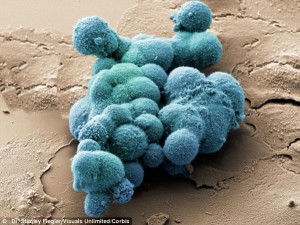 The spread of cancer from a tumor’s original location to other parts of the body can play a major role in whether the disease turns deadly. Many steps in this process, called metastasis, remain murky. But now scientists are gaining new insights into how cancer cells might squeeze through and even divide within narrow blood vessels while travelling in the body. They report their study using microtubular nanomembranes in the journal ACS Nano.
The spread of cancer from a tumor’s original location to other parts of the body can play a major role in whether the disease turns deadly. Many steps in this process, called metastasis, remain murky. But now scientists are gaining new insights into how cancer cells might squeeze through and even divide within narrow blood vessels while travelling in the body. They report their study using microtubular nanomembranes in the journal ACS Nano.
One thing scientists do know about metastasis is that spreading cancer cells elongate to fit through capillaries — blood vessels as fine as spider silk. They can get trapped in these skinny passages, but despite becoming misshapen, they seem to still be able to divide and form little colonies of cells before dislodging and moving on. If scientists could better understand this process, they could potentially improve anti-metastatic treatment strategies. But studying it in molecular detail is not possible with conventional analytical techniques. So Wang Xi, Christine K. Schmidt and colleagues used transparent, rolled-up nanofilms to study how cancer cells divide in capillaries.
The researchers trapped live cancer cells in the tubular membranes and, with optical high- and super-resolution microscopy, could see how the cells adapted to the confined environment. Cell structures significantly changed in the nanomembranes, but it appeared that membrane blebbing — the formation of bulges — at the cells’ tips helped keep genetic material stable, an important requirement for healthy cell division. The researchers say their technique could be a useful tool for further investigating metastatic cancer.
The authors acknowledge funding from the European Research Council, the Volkswagen Foundation, the German Research Foundation (DFG), the Federation of European Biochemical Societies, the Wellcome Trust, the Alexander von Humboldt Foundation, the U.S. National Science Foundation and Cancer Research U.K.
Written for the American Chemical Society and published in excerpt at Canada Free Press June 29, 2016.
FAIR USE NOTICE: This site contains copyrighted material the use of which has not always been specifically authorized by the copyright owner. We are making such material available in our efforts to advance understanding of environmental, political, human rights, economic, democracy, scientific, and social justice issues, etc. We believe this constitutes a ‘fair use’ of any such copyrighted material as provided for in section 107 of the US Copyright Law. In accordance with Title 17 U. S. C. Section 107, the material on this site is distributed without profit to those who have expressed a prior interest in receiving the included information for research and educational purposes. For more information go to: http://www.law.cornell.edu/uscode/17/107.shtml
